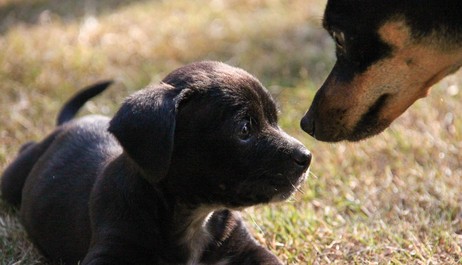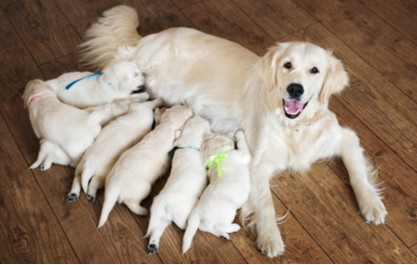Dogs get sad if you take their puppies from them too soon. You have to give her time to look after her puppies. Around seven to nine weeks old is optimal in most circumstances.
After this time, the mother is often over the work of puppies and is happy to see them go. Take one puppy at a time.
It’s very common for people to wonder if dogs get sad when we take their puppies. Maybe the person who asks the question has just got a new puppy, or they have taken a puppy from their dog and given it to someone else.They are then left wondering if they have done the right thing at the right time.
The short answer is yes, a dog is likely to get sad if you take her puppies from her. If you just randomly take her puppies, she will be sad. There is a process and timing is critical. Our goal is to remove the puppies at the right time to avoid making the mother sad.
In this article I’ll look at how to make sure your dog doesn’t’ become saddened when you take her puppies. I’ll also look at the timing of when you can start removing her litter and how to soften the blow if the mother dog gets upset or yearns for their litter.
Seven to Nine Weeks is the Time to Remove Puppies
The longer you can give your puppy with its mother the better, though many people have reported that the mother often snaps at the puppy after around nine weeks. It’s like she is saying she has done her job, now it’s time to go.
After around seven weeks, the mother starts to move away from her puppies, and this psychological distance increases up to nine weeks.
Some breeds may be okay with up to 12 weeks. Some owners say that the puppy has not been taught the basics of being a dog by the mother until then. They also say that removing the puppy before 12 weeks will cause behavioral issues the new owner will have to deal with.
As puppies get older and their teeth get sharper, the mother will try to find solace and get away from the puppies for a little while. It’s around this time you can start removing her puppies.
Don’t take them all though. If you take all of her babies at once, she will likely pine for them. One theory is that her hormones before, during, and after pregnancy will be high, making her motherly. As the weeks progress up to seven to nine weeks, those hormones decrease, and she initiates that distance between her and the puppies.
Removing puppies is natural and not cruel. In the past before domestication, puppies and their mother would have split up to avoid inbreeding.
Mothers get quite relieved once her puppies are separated from her (as long as you don’t do it too early) because she can get some rest and allow her teats to heal.
Modern Dogs Have Adapted to Separating from Pups
How a mother dog reacts to her puppies being taken away at the right age all comes down to the individual dog.
Some mother dogs act aggressively toward their puppies if they continue to be with them after six months.
Other mothers mope around for a while when their puppies are taken. They even adopt surrogate puppies or the young of other species so they can still be motherly and look after babies.
Basically, the individual dog’s personality will determine how they react,if they miss their litter, and for how long.
Some dogs react to losing their litter by maintaining their motherly instinct in strange ways. Mother dogs have been known to use soft toys as puppy substitutes; carrying them around the same way they would their own puppy.
This could be a link back to their wolf ancestors where families often stayed together in a pack, or it could just be the motherly instinct is particularly strong in that dog.
Make sure when you do separate mother from puppies, she is given special attention with lots of hugs and adventures. Some of the things you could consider for the mother when removing puppies include:
- Remove puppies only at the right time. Monitor the interaction between the mother and her puppies. If she is teaching them bite inhibition, how to act and how to play, allow them to stay together. Around the nine week mark, look for the distancing or aggression from the mother and begin to remove the puppies.
- Give her full access when she wants it. Allow the mother to have access to her puppies when she wants to. Provide her with an area for her to retreat to when she wants to be away from them.
- Reduce food to pre-pregnancy levels. Mother dogs require extra food and nutrients to grow and feed her litter. Once you have started removing puppies and she has around half left, return her diet back to what she ate before she became pregnant. This should also help her milk to dry up naturally.

- Be wary of the mother’s emotions. Although some mothers are quite comfortable fortheir puppies to be removed, others are inclined to become emotional. Try the following to help ease her into the transition.
- Remove only one puppy at a time for re-homing.
- Allow her to meet the families who are adopting her babies and let her see the puppies with them.
- Let her see the puppy get into their car and leave. This should stop her desperately trying to locate her puppy later on.
- Use a calming product on her if she becomes very upset. Talk to your vet as to the best one and how to use it.
- Spend quality time with her. Spend lots of time with her and play with her. Give her plenty of belly rubs so you can check for any nipple issues like mastitis. Concentrate on getting her back into top physical condition. Having puppies is very hard work on her body.
Mother Dogs Naturally Wean Off Their Puppies
If you think it’s hard to decide on exactly when to remove the puppy, take heart in the fact the mother dog will do it naturally anyway.
As many breeders and dog families have seen, the mother dog will wean her puppies off herwhen she is ready and when she is over the work of raising puppies.
- Sharp baby teeth. The mother will be over having her teats hurt every time the puppies feed.
- Following her around. The mother will often get aggressive as the puppies continuously follow her around to feed or climb all over her.
- Mother becomes possessive. She may snap at her puppies if they take a toy or something she didn’t mind them touching before.
- The bigger the litter, the harder the work.I know people who have a dog that tends to have very large litters. Last time she had 16 puppies. By the time they got to eight weeks, she was over it and it was obvious. When the puppies were removed, she was clearly relieved.
Mother Dogs May Look For Puppies For a While
You may find the mother dog looks for her puppies for a little while when you remove them. If she has five and you remove one, she will look for the fifth missing one, but only for a little while.
She will likely be so busy looking after the other four she will soon concentrate on that task. This is why it’s important to the process to not take all of her puppies at once.
When a stillborn puppy is removed at the time of birth, mother dogs will often spend time looking for them later. They are acutely aware of how many they should have.
The Lowdown on Separating Mother and Puppy
Removing puppies from their mothers is a natural and necessary task. If you do it at the right time, the process benefits the mother, the puppy and the new owners of that puppy.
Doing it too soon causes anxiety and stress for the mother and you will likely cause behavior issues in the puppy that the new owner will have to contend with.
As tempting as it is for some people to want to take a new born puppy home, the mother has a bit of work to do first. She will feed and groom her puppy, they will learn from her and when she is ready, you can take them.
Timing is key.
Writer: Craig Taylor

References

